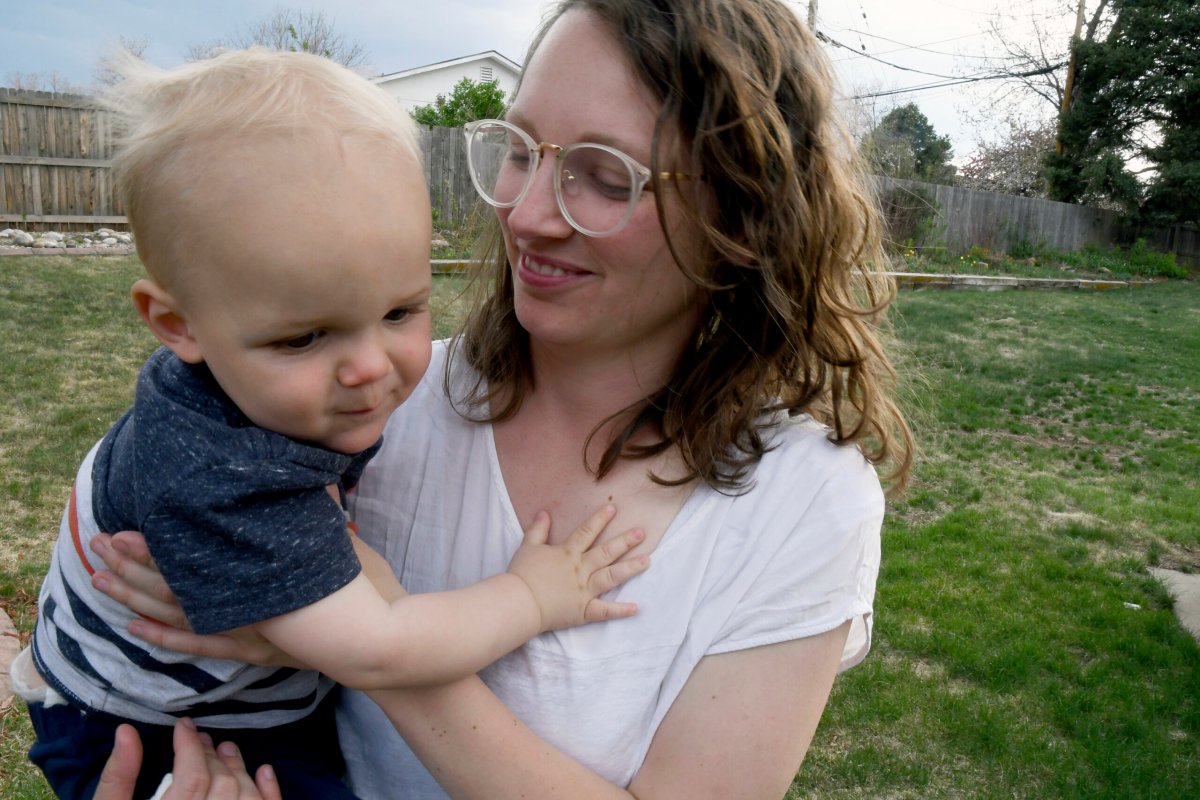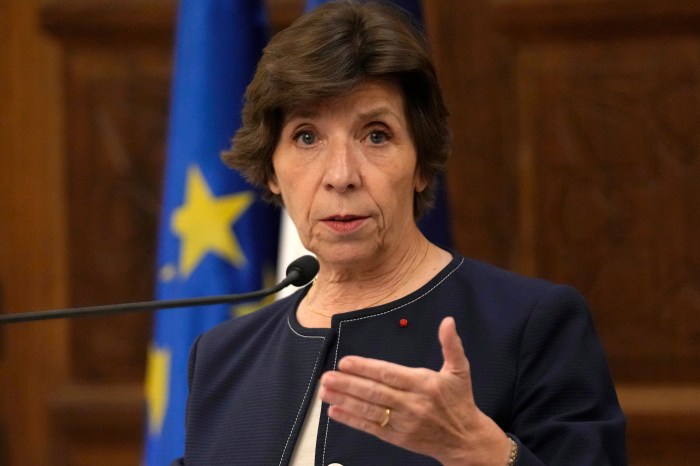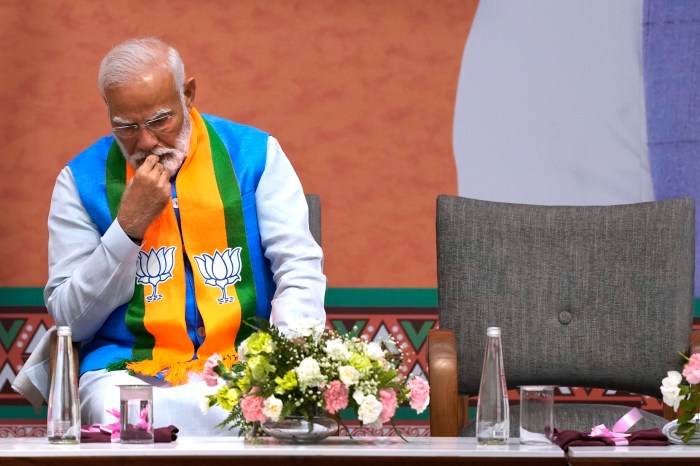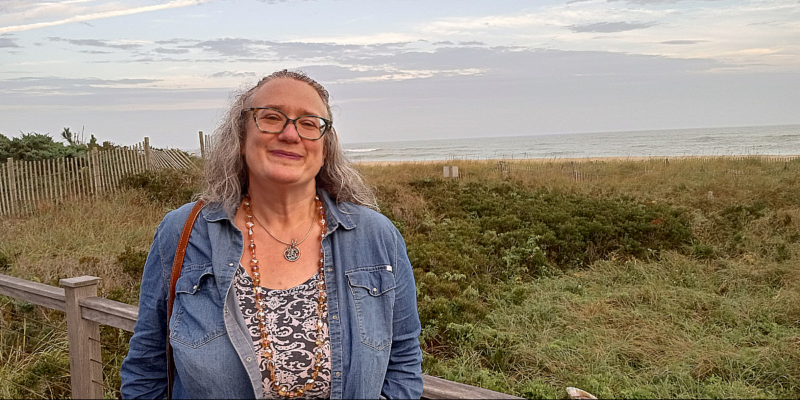BOSTON (AP) — When child welfare workers and police knocked on Sarah Perkins’ and Joshua Sabey’s front door well past midnight one weekend last summer, the parents were shocked to learn the state of Massachusetts had come to take their two young sons.
It’s the kind of harrowing scene that plays out daily across the country as social workers motivated by a desire to protect children run up against confused and concerned parents.
What followed was emotional anguish, a bureaucratic battle, vindication for the parents and a lawsuit filed earlier this month by a legal advocacy group. The couple hopes for a favorable ruling that will increase oversight of child removals nationwide.
The children were taken in Massachusetts because of a child abuse report stemming from a hospital visit. On July 13, 2022, Perkins whisked their 3-month-old son Cal to an emergency room. He had a 103-degree fever.
An X-ray checking for pneumonia found a rib fracture the couple hadn’t noticed. After speaking with the boy’s grandmother, they learned the injury may have happened weeks earlier as she removed Cal from a car seat. He slipped, and she caught him with one arm.
Citing the fracture, hospital officials reported potential abuse to the Massachusetts Department of Children and Families.
“It was such a roller coaster — this total terror that we’re going to lose this child at the hospital and then complete relief after we’re allowed to go home with a safety plan,” Perkins said.
They returned to their Waltham, Massachusetts, home. DCF social workers made a surprise visit and found no evidence of abuse, according to the lawsuit.
Days later, around 1 a.m. on July 16, DCF workers and police officers knocked at their door to take both sons away. They didn’t have a warrant or a court order, neither of which are required to remove a child in Massachusetts and other states.
“It was intense. We see that these police officers are armed. We’re asking for paperwork and there’s none to be had,” Perkins said. “Eventually we were told that either we hand over the kids or they’re going to break down our door and take them by force.”
Within 24 hours, Sabey’s parents were allowed to act as foster parents. Four weeks later DCF let Sabey and Perkins take their children home, and after another three months and eventually about $50,000 in private attorney fees, the government restored full parental custody. A short time later the couple moved to Idaho.
The couple’s lawsuit alleges constitutional violations including the unreasonable search of their house, the unreasonable seizure of their children and the deprivation of parental rights without due process.
“What’s really frightening is that it happens a lot. What was unique was our ability to hire an attorney,” Sabey said.
The couple are plaintiffs in a lawsuit filed by the Pacific Legal Foundation, a nonprofit focused on parental rights and other issues. It asks for compensatory and punitive damages.
It’s also part of a legal strategy to set precedent nationwide “confirming the importance of parental rights and clarifying the need to include a neutral judge in child removal decisions unless there is an emergency situation involving a risk of imminent harm to a child,” said Glenn Roper, a lawyer for the foundation.
The lawsuit names individual social workers, police officers and the City of Waltham, not the DCF. That’s in part because state agencies effectively can’t be sued in federal court for damages, according to Joshua Thompson, Pacific’s director of legal operations.
Perkins and Joshua Sabey say they feel responsible to pursue the lawsuit because many other parents can’t pay private attorney fees.
Joyce McMillan wasn’t so fortunate.
She relied on a public defender 23 years ago when her two children were removed after a drug test turned up positive for what the New York resident described as an illicit substance. McMillan said she had a job, a home, and was providing for her children.
“A drug test is not a parenting test,” she said.
McMillan said she fell into a depression and became homeless before getting her children back more than two years later. She’s currently executive director of the nonprofit JMACforFamilies. The group advocates for dismantling the child welfare system, which it calls “the family policing system.”
Welfare agencies should be required to advise families that they have a right to an attorney and typically don’t have to let them speak to their children or enter their home without a court order, McMillan said.
If she had deeper pockets at the time, “absolutely there would have been a different outcome,” she said.
A representative from the City of Waltham had no comment on the Massachusetts case.
The DCF also declined to comment. DCF policy allows the removal of a child without a court order when needed to avoid “a substantial risk of death, serious emotional or physical injury or sexual abuse” and when there’s “inadequate time to seek” one, but it must immediately file an affidavit.
Massachusetts Gov. Maura Healey, a Democrat, declined to comment on the lawsuit. She said her administration “is committed to making sure we do everything we can for the health and well-being of children and families.”
There are efforts to restrict the authority of child welfare agencies.
A bill before Massachusetts lawmakers would require child welfare workers get judicial approval within four hours of removing a child, according to bill sponsor Democratic state Rep. Joan Meschino. It would also make it easier for workers to contact judges outside of regular court hours, including overnight and on weekends.
An estimated 3 million children came under the scrutiny of child welfare agencies in the 2021 fiscal year. Nearly 600,000 were victims of mistreatment, according to a report by the Department of Health and Human Services’ Administration for Children and Families.
An estimated 1,820 children died from mistreatment during that same period.
The report found that 76% were victims of neglect while 16% were physically abused, and 10% were sexually abused.
The child welfare system can be particularly risky for Black and indigenous families, according to Dorothy Roberts, professor of Africana studies, law and sociology at the University of Pennsylvania.
“The main reason why families get investigated is accusations of child neglect, which is basically defined as not meeting the needs of children like sufficient clothing or housing or child care,” she said. “It’s basically a definition of poverty.”
Instead of removing children, the government could help parents meet their needs, she argued.
Roberts pointed to a 2017 study that estimates more than one-third of all U.S. children will be the subject of a child abuse or neglect report before they turn 18, an estimate that jumps to more than half for Black children.
But social workers aren’t out to get children; they’re trying to protect them, said Yvonne Chase, president-elect of the National Association of Social Workers.
When a hospital, school, neighbor or older child reports mistreatment, social workers apply a risk assessment to determine how agencies should respond, she said.
“The child protective agency doesn’t create the reports of harm. Somebody calls us,” said Chase, a former head of child protective agencies in Alaska and Washington. “If a child is being seriously abused, they may be very happy to see that some relief is coming.”



















